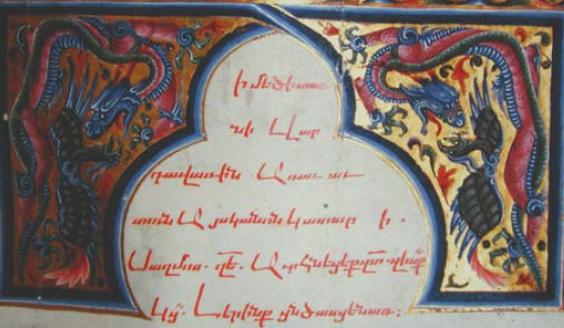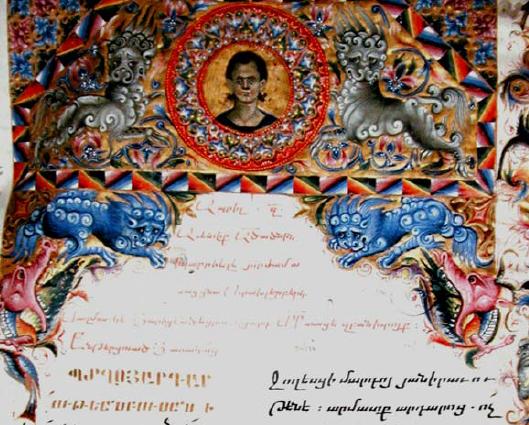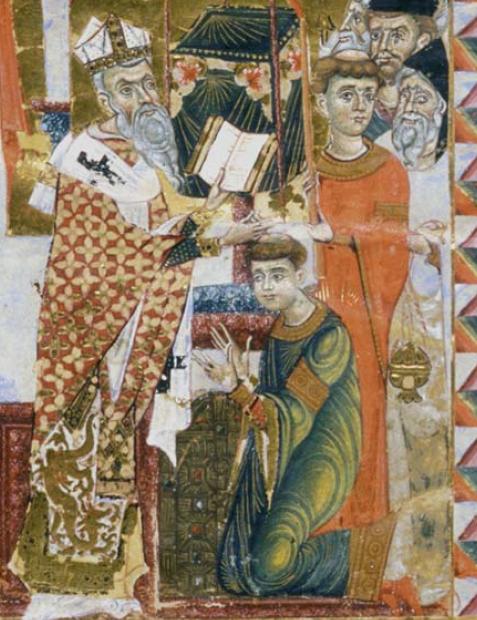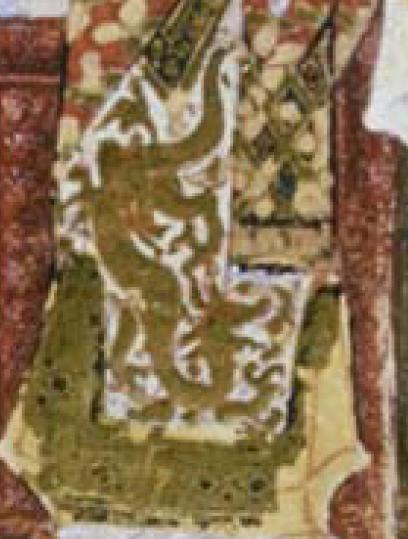Chinese Dragons Head West January 3, 2014
Author: Beach Combing | in : Medieval , trackbackDragons have long been part of the mythic corpus of Europe, Asia and Africa and, if you include the various Amerindian Giant Serpents, the Americas as well. However, different cultures celebrated or reviled dragons in different ways and a dragon from Sweden with a breath that reaked of ragnarok and a wingless dragon from China smooching around an emperor like a cat around his mistress are two very different things. Today’s post is to signal one remarkable medieval example of a travelling dragon motif. Dickran Kouymjian, a venerable and much respected Armenian wanw, has demonstrated that the Chinese dragon sidled west as far as Armenia in the thirteenth century. (DK’s article is, at least for now, available online so take advantage.) We’ve headed this post with the beautiful image of (clearly) Chinese dragons, from the thirteenth-century Armenian Lectionary of Het’um, facing off on either side of an Armenian arch, placed in violent opposition to Chinese phoenixes. There is a Chinese motif – though it appears later than the image here?! – where Chinese dragons and phoenixes are placed in peaceful balance. It looks very much as if the motif has been misunderstood (or has been ‘re-elaborated’) by the Armenian artist into a sparring pair. And if you want to see what an indigenous Armenian dragon looked like turn, instead, to a Christ headpiece from the same work. Christ is surrounded by, you guessed it, Chinese lions, two grey and two blue (note the knotted tail) and they are guarding him, from two ‘dragons’ below that look rather less impressive than their Chinese equivalents above: think sticklebacks with attitude.
How did these dragons and other Chinese motifs make it this far west, just shy of the Christian heartlands? China was essentially Mongol in this period and the Mongols (albeit different Mongols) were essentially rulers of even the western Armenians. Gift exchange at Mongol courts probably answered for most of the contacts – a Buddhist prayer wheel appears in one Christian manuscript! – though never underestimate how far an Armenian might have travelled for trade. A delicate and astoundingly beautiful proof of goods travelling west appears in the image below where an Armenian, Archbishop John (obit 1289) is ordaining a priest. The illuminator – the manuscript was produced in the year of the Archbishop’s death – shows John wearing under his priestly paraphenalia, a Chinese silk with an unmistakable Chinese dragon peeking out.
Silk, of course, had travelled west for centuries, but rarely survives. If we had visited the court of Charlemagne or Constantine or Augustine would we have found the odd baron/secretary/senator similiarly attired? Did this westward travelling dragon influence the dragon lore of the west? drbeachcombing AT yahoo DOT com
And just for anyone who missed it that tease of Chinese dragon again…
8 Jan 2013: The Count writes ‘My apologies for out Sherlock Holmes-ing you here, but in mediaeval Christianity, dragons were so closely associated with Satan that the two were often literally interchangeable. The illustration you use as your sole evidence depicts an Archbishop wearing robes with dragons on them. That’s like a Rabbi wearing a swastika! Unless of course Archbishop John had no idea that the ornamental squiggly creature on his very expensive new dress was supposed to be what he thought of as a “dragon” (which it wasn’t, despite vague visual similarities to much more modern Western dragon illustrations). He presumably didn’t know either that it was a greatly revered supernatural being worshiped by pagans, as opposed to a weird pretend animal put there purely for decorative purposes, as it would have been if the robe had been embroidered according to the current Western conventions of heraldic art.’ Thanks Count!






